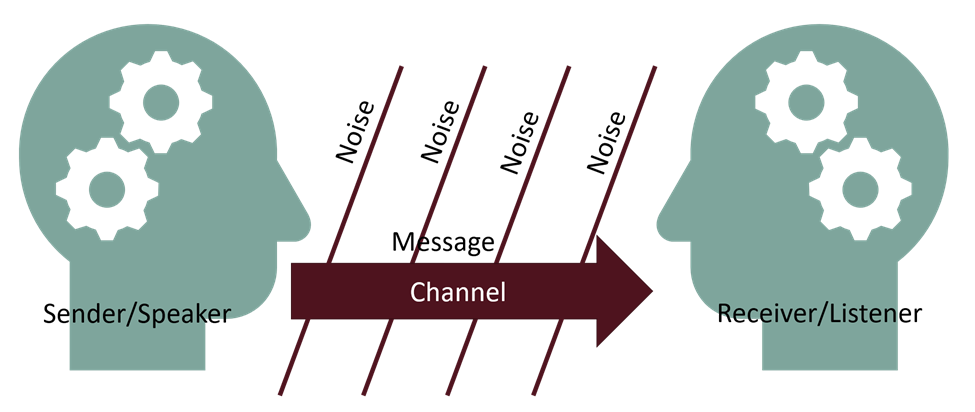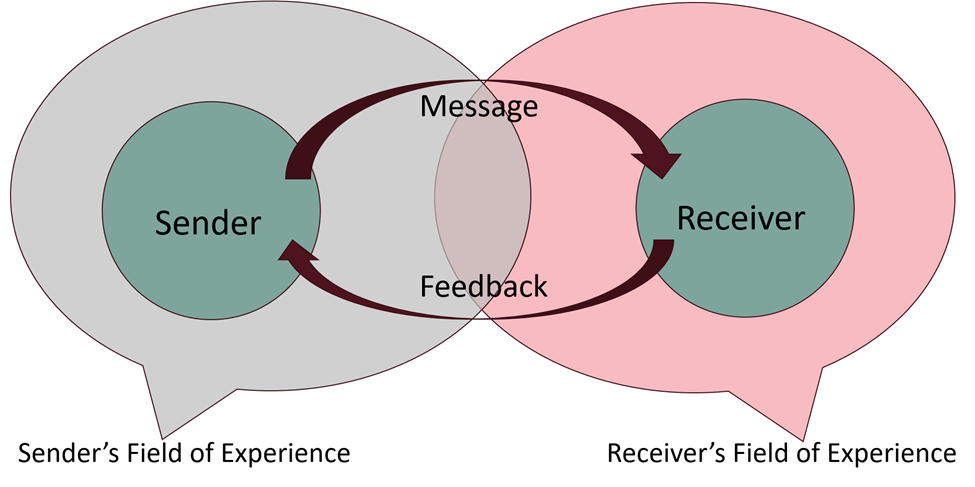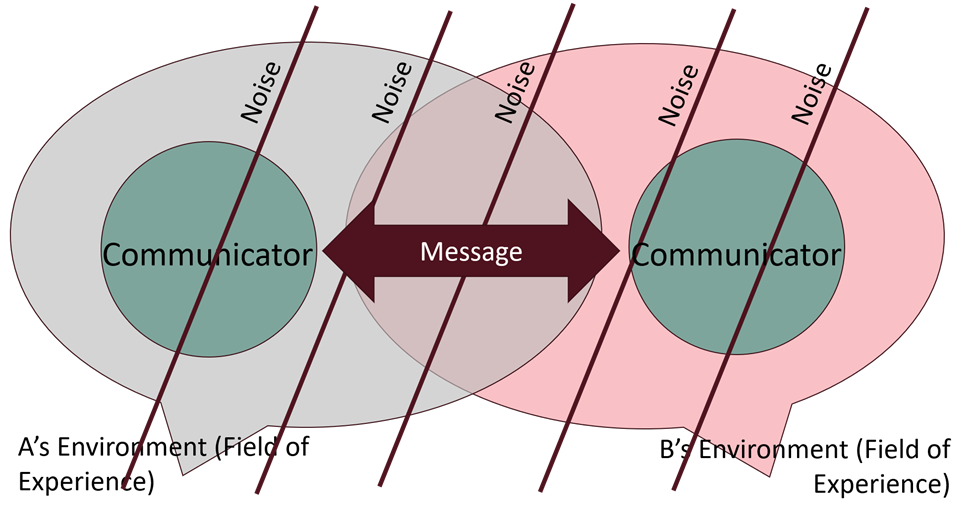Chapter 9: Effective Communication
9.1 What is Effective Communication?
It’s a common assumption that because we spend most of our days talking, listening, and reading that we are automatically great communicators. However, quantity does not equal quality. We can spend a lot of time reinforcing bad habits. Think of effective communication as a series of skills and practices that you develop intentionally through practice. The great news is that because professional communication is skill-based, you can become more effective at communication and see the results in happier co-workers, clients and even friends and family!
Let’s begin with a definition of effective communication. Effective communication is a communication between two or more persons where the intended message is successfully delivered, received, and similarly understood in a clear and concise format. (Business Jargons, 2021).
As noted in Chapter 6: Workplace Essential Skills, oral communication, reading, and writing are three of the nine essential employability skills. These are valuable skills in the workplace.
Effective communication in the workplace saves money and improves morale, efficiency, engagement, and creativity. Bad communication has a lot of costs. For example, think of the money, time, and frustration that occurs when you are trying to read a poorly written set of instructions. Think about the number of times you have received bad service or needed to send multiple emails to get your question answered. You can also think about a terrible worse case scenario: imagine miscommunicating life or death information on a patient file.
Communication Process
First of all, you need to understand the basic communication process. While there are a number of models of communication, including linear, interactional, and transactional, let’s start with a few of the key terms. All communication begins with a source, also known as the sender or speaker. They will determine the message and then encode, decide what to say and how to say it, in words, behaviours, or sounds. The source sends the message along a channel. When choosing a channel consider the audience (receiver) and appropriate format (for example, a phone call, a text or an email, or a face-to-face conversation). Remember the channel could even be non-verbal. When the receiver, also referred to as the listener, receives the message and decodes it, interprets the message. Other factors include the environment or space in which the message is sent and received, as well as the context, this is the circumstances that form the setting for sending and receiving the message. And finally, communication is influenced by interference or noise, these are the factors that can block or alter the message (WSBCTC, n.d.).
Let’s look at this in an example to see it in action.
Case Study: Talia Receives a Message
Talia is on the phone with a client looking to book an appointment. The client, Mr. Armstrong, is the source or sender of the message. The message is that he would like to book an appointment. This is a pretty straightforward message for Mr. Armstrong to encode and for Talia to decode. The channel is verbal and over the phone. This would mean that there is no eye contact or body language cues for the sender or the receiver. Also, neither can see the environment that they are sending their messages in. Mr. Armstrong might be calling from a quiet office with little or no interruption, whereas Talia may be surrounded by busy co-workers and a waiting room full of furry patients and their owners. This is also where context can come into play. Mr. Armstrong may have just gotten a customer complaint and still feel upset about that, or Talia may have just had a puppy patient pee down her clean uniform. And finally, interference can affect the communication process. Talia may not be able to hear Mr. Armstrong well because she is in a noisy room or Mr. Armstrong may have a quiet speaking voice which makes it difficult for Talia to hear.
Communication Models
Looking at some of these communication models will help you further understand these elements. The linear communication model, illustrated below in Figure 9.1, describes how a speaker transmits a message to a listener through a channel. The message can be comprised of words, sounds, or behaviours. Obstacles that interfere with the message are considered noise.

The interactional communication model, illustrated below in Figure 2, incorporates feedback from the receiver as well as taking into consideration both the sender’s and receiver’s field of experience. The field of experience includes the environment, culture, experiences, and upbringing that can influence the message for both the sender and the receiver. You may notice that one difference between the linear and the interactional communication models is the idea of feedback. Seldom are we communicating in a vacuum where our message is not received and reacted to either through words or non-verbal cues. Another difference is the incorporation of the field of experience which acknowledges again that messages are neither sent nor received in a vacuum but impacted by a number of characteristics.

Thirdly, there is the transactional communication model, illustrated below in Figure 3, like the interactional model, the transactional model considers and places more emphasis on the field of experience and incorporates more overlap between the sender’s and receiver’s fields of experience. This principle demonstrates a connectedness between the messages and the people involved in the process are “dynamic” rather than static and each party is engaged in a transaction of give and take building the message together. You see this in the change of terms from sender and receiver to communicator.

Watch the following video for more information on the communication process.
Activity
Looking at the three communication styles explained above; linear communication, interactional communication, and transactional communication, fit the best answer to the communication style.
- The linear communication model is when a speaker transmits a message to a listener through
- noise.
- a receiver.
- a channel.
- The transactional communication model is the exchange of messages between
- message and feedback.
- different stages of noises.
- communicators.
- The interactional communication model is a process in which the sender and receiver generate meaning by sending messages and receiving f
- feedback.
- communication
- static.
Verbal, Non-Verbal and Written Communication
All communication can be classified into three main types: verbal, nonverbal, and written. All three use a similar model of the sender encoding a message and sending it along a channel where the receiver decodes it. Each of these types has certain advantages and disadvantages. Verbal communication in a face-to-face format is quick and offers the opportunity for immediate feedback. However, verbal communication may not allow time for reflection and careful consideration.
The second type of communication, nonverbal, includes the elements of body language, eye contact, facial expressions, hand gestures, posture, and even space (Saylor Academy, 2012). There are a number of cultural factors that can influence the interpretation of nonverbal communication. Therefore, it is important not make assumptions about nonverbal cues and to ask if you need clarity. This could be considered a barrier to communication. Let’s look at this topic now.
The third type of communication, written communication, includes emails, texts, signs, cover letters, resumes, job evaluations, and anything else communicated by writing. Written communication may also be advantageous when you need to send the same information to a large group of people. For example, a new policy at work can be written up and posted. Whereas the same information shared verbally one by one to employees of a large organization would take a long time and have more chance of misinterpretation. While written communication allows for more reflection in the writing process and even editing and proofreading, it does not offer immediate feedback from the receiver.. Remember to consider the message and the channel when planning communication.
Barriers to Communication
As shown in the example of Talia and Mr. Armstrong’s conversation, there can be a number of things that cause interference in the communication process, such as the busy veterinarian office or Mr. Armstrong’s quiet voice. Often this interference is referred to as barriers to communication.
Take a moment to reflect on what might be some barriers to communication that you have encountered. Refer to chapter
Let’s look at some common barriers to communication.
Physical Communication Barriers
There are a number of elements of the physical environment that can get in the way of effective communication, such as noise, busyness, having a lot of other people in close proximity, and distractions. Many times, these are simply a fact of the environment that you work in, for example, it’s not always possible to ask everyone to leave the room while you take a phone call at the reception desk. However, if Talia needed to talk to a patient whose pet has a serious health condition about arranging a payment plan, she may want to do that in a quieter place. Think about what is possible in terms your physical environment and the circumstances or the context of the situation.
Emotional Communication Barriers
Have you ever found yourself stammering a bit when talking to someone you are nervous around? This is an emotional barrier to effective communication. Emotional barriers can include fear, mistrust, lack of self-confidence, and nervousness about the situation or the person you are communicating to. The scenario above also includes an emotional communication barrier, the client could be experiencing fear for their pet’s health as well as anxiety about an expense vet bill that might be hard to budget for. Emotional communication barriers can also come from stress, pressure and anxiety. For example,at the end of Talia’s first week her boss, Dr. Jones, would like to give her some feedback on her performance. Performance anxiety is common, as is stress related to a lack of certainty. Knowing that feedback is coming may cause Talia to feel nervous which may interfere with her ability to communicate clearly and concisely.
Language Communication Barriers
Have you ever misheard or misinterpreted what someone said? Language communication barriers can include the words you or your receiver choose or the features of sound and voice. Using jargon, technical terms, or other types of language can interfere with the decoding process and inhibit your complete understanding. Another barrier happens when the person says something in an overly complicated way or gives too much information all at once. Have you ever lost the point in a long email? That could be because of a language communication barrier! Similarly, the volume of someone’s voice – either too loud or too quiet – or a heavy accent can get in the way of properly understanding the message. Mr. Armstrong’s quiet voice made it difficult for Talia to hear and therefore understand him completely, especially in the context of the busy reception desk.
Watch the following video exploring further common barriers to effective communication:
Activity
Consider what barriers get in the way of you communicating effectively. Is there a way to remove or reduce those barriers? Let’s look at a few scenarios and see if you can identify the main barrier and a way to resolve it.
Referring to the above barriers to communication and information from the video determine which communication fits each scenario.
- Ms. Anderson, a twenty-something client with an obedient border collie named Max, comes up to the reception desk to pay for the services. She is visibly shaken and upset. Talia explains the bill to Ms. Anderson and asks her how she would like to pay. When Talia doesn’t receive an answer, she asks again. There is still no response from the client, so Talia needs to ask a third time. Ms. Anderson apologizes for this and explains she has just found out that Max needs a biopsy and she’s worried that the condition could be serious.
- Language Barrier
- Emotional Barrier
- Physical Barrier
- Talia receives a phone call from Mr. Singh inquiring about the bill he received in the mail for the recent treatment of Puddles, his basset hound. He questions why he is being billed for otitis externa when his basset hound only has an inner ear infection. Talia explains that otitis externa is the scientific name for an inner ear infection.
- Language Barrier
- Physical Barrier
- Emotional Barrier
- It’s a particularly busy afternoon at the vet clinic, George comes in with three of his sled dogs. They immediately spy Mrs. Cooper’s tabby cat, which causes them to begin barking uncontrollably. Talia is unable to hear the post-op instructions that Dr. Jones is relaying to her.
- Language Barrier
- Physical Barrier
- Emotional Barrier
- Mr. Nikolovski has been coming to Pawsome Animal Hospital for years with his various pets. He is very friendly and loves to tell the front desk staff long stories about his life in Macedonia. One day after he leaves, Denise admits to Talia that because of Mr. Nikolovski’s strong accent she never fully understands what he tells her, rather she just smiles and listens politely.
- Language Barrier
- Emotional Barrier
- Physical Barrier
- Ms. Potts has brought in her guide dog for a check up. Talia tells her to take the dog “over there to get weighed on the scale”. Ms. Potts is vision impaired, so she asks, “Where is over there?”
- Physical Barrier
- Language Barrier
- Emotional Barrier
Media Attributions
- “Figure 9.1 Linear Communication Model” by Deb Nielsen, Emily Ballantyne, Faatimah Murad and Melissa Fournier is licensed under a CC BY-NC 4.0 licence. Based on Corey, A. (2019).
- “Figure 9.2 Interactional Communication Model” by Deb Nielsen, Emily Ballantyne, Faatimah Murad and Melissa Fournier is licensed under a CC BY-NC 4.0 licence. Based on Corey, A. (2019).
- “Figure 9.3 Transactional Communication Model” by Deb Nielsen, Emily Ballantyne, Faatimah Murad and Melissa Fournier is licensed under a CC BY-NC 4.0 licence. Based on Corey, A. (2019).
- “How miscommunication happens (and how to avoid it) – Katherine Hampsten” by TED-Ed is licensed under a Standard YouTube License.
- “10 Barriers to Effective Communication” by Jijo’s Skill Factory is licensed under a Standard YouTube License.

